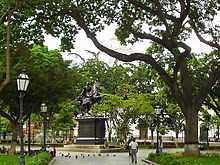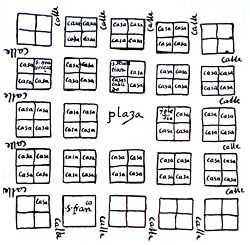Plaza Bolívar (Caracas)
| Plaza Bolívar | |
|---|---|
 | |
| Location | Caracas, Venezuela |
| Dedicated to | Simón Bolívar |
The Plaza Bolívar in Caracas is one of the most important and renowned public spaces in Venezuela and is located in the historic center of the city in the Cathedral Parish of Libertador Municipality in the central block of 25 with which it was created Santiago de León de Caracas in 1567.
The Plaza Bolívar is surrounded by important buildings like the Cathedral of Caracas, the Sacred Museum, the Archbishop's Palace, the Municipal Palace, the Chapel of Saint Rose of Lima, the Yellow House, the Teatro Principal and the building of the Government of the Capital District, southwest addition it is the Federal Legislative Palace.
History
When Caracas was originally founded, it was intended to have the Plaza Mayor, serving as a center of trade in that town. At that location, some modifications were made for centuries but one of the most significant was in 1754 when Governor Felipe Ricardos ordered the construction of some arches to surround the square.

The square was the usual place of executing political enemies and conspirators against the Spanish colonial government, the most popular being José María España, where his body was quartered in the square in 1799. The square was also the site of where Venezuela achieved its first step toward independence, giving rise to a popular rebellion against the Spanish crown on 19 April 1810.
After Venezuela won its independence, the square was called Plaza de Armas and Plaza del Mercado, until in 1842 when the remains of Simón Bolívar arrived from Santa Marta in Caracas and was the square was formally named Plaza Bolívar; although the name would not be used as such until 1874.[1]
In 1865 the Marshal President Juan Crisostomo Falcon briefly gave power to General Antonio Guzmán Blanco, he decided in May of that year to demolish the arcades around the plaza 2 and to close the markets. When Guzman Blanco ascended to power years later, he decided in 1872 to renovate the square in a French style.
On 18 November 1872, Guzmán Blanco had a statue erected in honor of Bolívar and in addition, it was decided to build planters, plant trees, and recreate in the corners the four seasons; spring, summer, autumn and winter with four sources of ornamental iron, installing 100 iron posts with different decorations and surround the square with a baluster metal. Small stairs southeast of the square gave name to that corner called "Gradillas" ("racks").
Statue
On 7 November 1874, the statue of Simon Bolivar was inaugurated in the center of the square with the ringing of bells and a 21 gun salute. The statue, made by the Italian sculptor Adamo Tadolini, is a replica of the statue of the Plaza Bolivar in Lima, Peru by Von Müller Foundry. It measures 4 meters high and has Bolívar on a rearing horse held by their hind legs resting on the pedestal which has two tiers. In 1894, it was decided to put electricity in the square and since then significant changes would not occur until 1967, when the original floor was colored by gray marble is removed. Between 1908 and 1947, they performed at the corners of the square several terminals trams Caracas. On 21 February 1959 the statue was designated as a memorial. In mid-2003, the Mayor of Libertador initiated a complete restoration process that included the square gardens, fountains, floor, lighting, among others.
References
- ↑ "Distrito Capital - Plaza Bolívar". Bolivarian Government of Venezuela. Retrieved 22 February 2015.